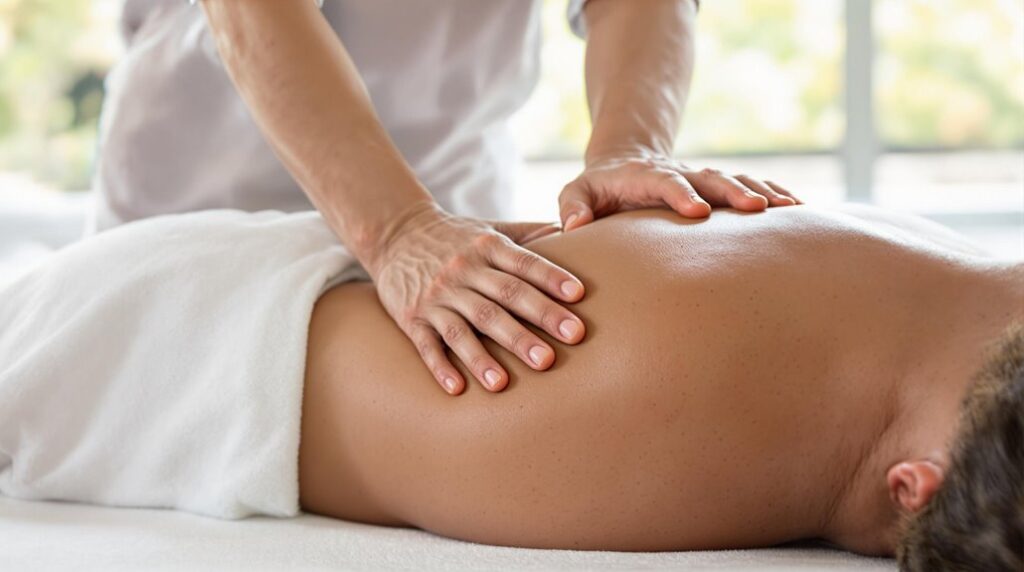You'll want to start with a thorough injury assessment before applying deep tissue massage techniques. Begin with light pressure in the first 48-72 hours, gradually increasing intensity as healing progresses. Perform essential pre-massage evaluations of range of motion and pain levels, then target the primary injury site before addressing connected muscle groups. Monitor recovery through systematic tracking of mobility and strength improvements. These fundamentals will guide you toward ideal therapeutic outcomes.
Understanding the Injury Before Treatment
Before beginning any deep tissue massage treatment, you'll need to thoroughly assess the sports injury to determine its severity, location, and underlying causes. You'll want to check for signs of acute inflammation, such as redness, swelling, or localized heat, which can indicate whether it's safe to proceed with massage therapy.
During your assessment, you'll need to identify the specific muscles, tendons, or ligaments affected by the injury. Consider the mechanism of injury – whether it resulted from overuse, trauma, or poor biomechanics. You should also review the client's medical history and any previous treatments they've received. If you're uncertain about the injury's nature or severity, it's essential to refer the client to a healthcare provider for proper diagnosis before proceeding with deep tissue work. Additionally, understanding muscle tear recovery times is crucial for tailoring the treatment to ensure optimal healing.
Timing and Pressure Techniques
When applying deep tissue massage for sports injuries, precise timing and appropriate pressure levels play vital roles in the recovery process. You'll need to start with light pressure during the first 48-72 hours after injury, gradually increasing intensity as healing progresses. Begin at 2-3 on a 10-point pressure scale, working up to 6-7 for deeper tissue work.
For ideal results, you should apply sustained pressure for 20-30 seconds on each trigger point, releasing slowly to allow the tissue to respond. During acute phases, limit sessions to 15-20 minutes; as recovery advances, you can extend to 30-45 minutes. It's essential to maintain consistent rhythm while varying pressure according to tissue resistance, adapting your technique when you encounter particularly tender areas or muscle knots. Additionally, utilizing neuromuscular techniques can enhance the effectiveness of deep tissue massage in addressing specific areas of tension and promoting recovery.
Essential Pre-Massage Assessment
A thorough pre-massage assessment serves as the foundation for effective sports injury treatment and ideal recovery outcomes. You'll need to evaluate the client's range of motion, pain levels, and tissue quality before beginning any deep tissue work. Start by examining the injured area and surrounding tissues, noting any swelling, discoloration, or temperature variations.
You should gather essential information about the injury's mechanism, including when and how it occurred, and review the client's medical history for contraindications. Don't forget to assess the client's current pain levels using a numerical scale and document areas of referred pain. Testing muscle strength and flexibility will help you determine the appropriate pressure and techniques to use during the massage, while identifying compensatory patterns that may affect the recovery process. This assessment not only aids in tailoring the massage but also aligns with the principles of preventing future injuries, ensuring a holistic approach to recovery.
Targeted Muscle Group Approach
Since successful deep tissue massage relies on systematic progression through affected muscle groups, you'll need to develop a targeted approach that addresses both primary and secondary areas of concern. You'll want to identify interconnected muscle chains and work through them methodically, starting with superficial layers before progressing to deeper tissues.
- Begin with the primary injury site, evaluating tissue texture and identifying adhesions
- Move outward to connected muscle groups that may be compensating for the injury
- Focus on trigger points and areas of referred pain that could be contributing to dysfunction
- Address antagonist muscles to guarantee balanced treatment and prevent compensatory issues
When you're working with specific muscle groups, you'll need to adjust your pressure and technique based on the tissue's response and the injury's healing stage.
Recovery Monitoring and Progression
To effectively guide treatment protocols and optimize recovery outcomes, practitioners must implement systematic monitoring strategies throughout the deep tissue massage therapy process. You'll need to track key indicators like range of motion, pain levels, and functional movement scores before and after each session to measure progress accurately.
Document your recovery milestones using assessment tools such as pain scales, mobility tests, and strength measurements. You should adjust the pressure and technique intensity based on your body's response and healing progress. If you're experiencing increased soreness or reduced mobility, it's crucial to communicate this to your therapist so they can modify their approach. Remember to maintain detailed records of your treatment responses, as this data will help determine when you're ready to advance to more intensive techniques or return to regular athletic activities.

